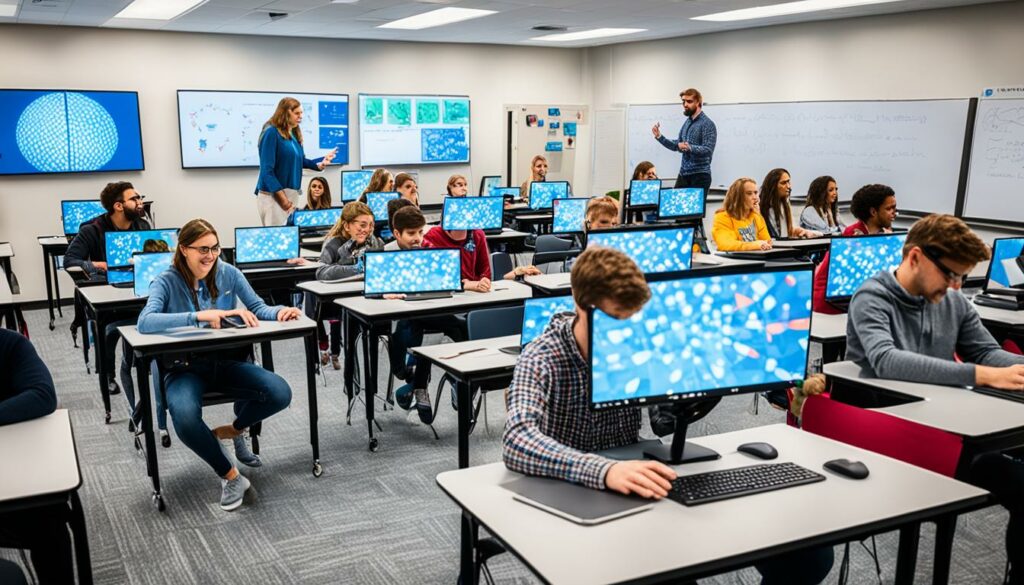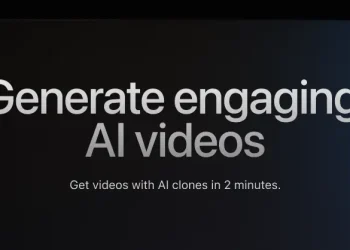Did you know that over 60% of educators are now using AI in educational technology? This trend is changing how we teach, blending old methods with new tech. AI is making learning fun and tailored to each student’s needs. It helps teachers by doing tasks like planning lessons and grading, so they can focus more on students.
With tools like real-time collaboration tools, the way we work together is changing. AI is bringing new ways to learn and grow, through systems that adapt to each student. It’s important to understand how AI is changing education, making teaching better and improving student results. But, we also need to think about keeping data safe and private.
Key Takeaways
- AI makes learning more personal for students.
- Teachers have more time to teach because of AI.
- Adaptive learning systems help students grow more.
- Tools for working together in real-time make teaching better.
- Keeping data safe and private is key with AI in schools.
- Many teachers want to learn more about using AI ethically.
- AI’s role in classrooms will grow, but its effects will change.
The Role of AI in Modern Education
Artificial intelligence, or AI, is now a key part of today’s education. It helps make online learning better by offering tools that improve the learning experience. AI in educational technology lets teachers create learning environments that fit each student’s needs.
Platforms like DreamBox and Knewton use AI to change the difficulty of tasks based on how well students do. This makes learning more engaging and helps students learn better. AI also gives students feedback that helps them understand their subjects better, thanks to tools like MATHia and Watson Tutor.
AI is also important for analyzing data in education. Tools like Gradescope use AI to help teachers grade work and give feedback, saving them time. BrightBytes and IBM’s Predictive Analytics can spot students who might be falling behind, so teachers can help them sooner.
AI has made learning more accessible for everyone. For example, Microsoft’s Seeing AI and Google’s Live Transcribe help students with disabilities learn better. VR and AR tools like Google Expeditions and ClassVR make learning more exciting by bringing subjects to life.
AI is changing education in big ways. It gives teachers real-time insights and helps students learn in ways that fit them best. This makes education more engaging and personal for everyone.
Understanding AI in Educational Technology
AI in educational tech changes how we learn, offering new ways that fit different learning styles. It makes learning adapt to each student, making it more effective. This approach prepares students for the changing job market. A study with 1,000 U.S. university students showed how students view AI in education.
AI helps with grading and tracks student progress. This info helps teachers tailor their lessons for each student. Tools powered by AI give feedback in real-time, helping students improve continuously. Interestingly, 75% of students see AI as a double-edged sword, useful but also a concern about cheating.
Companies are making AI tools easier to use in schools. Schools use AI to make learning fun and to test students in new ways. Research points out ten key areas for AI policies in universities. In Hong Kong, a tech hub, data from students and staff helped shape these policies.
AI and machine learning do more than just test students. They prepare students for a future where their skills will be crucial. The research article shows the need for AI skills among students and teachers. By using these technologies, schools can give students a well-rounded education.
Benefits of AI in Learning
Artificial intelligence in education brings many benefits that change how students learn and interact with school materials. Now, personalized learning is more important as AI gets better. This means each student gets lessons that fit their own learning speed and style. This makes learning more effective and helps students understand and remember better.
Personalized Learning Experiences
AI can make learning materials fit each student’s needs. It looks at how well each student is doing and changes the lessons and speed to match their learning style. This makes learning more personal and lets students enjoy subjects they like.
Increased Engagement and Motivation
Using AI in schools makes students more engaged. AI uses fun and interactive parts in lessons to get students involved. It also gives quick feedback on how they’re doing, which motivates them to do better. This makes learning more exciting and keeps students interested in their studies.
| Benefit | Description |
|---|---|
| Tailored Content | AI customizes learning materials based on a student’s performance and preferences. |
| Increased Efficiency | Automates grading and administrative tasks, giving educators more time for interaction. |
| Instant Feedback | Provides immediate data to students, facilitating better comprehension and retention. |
| Early Intervention | Identifies students at risk of underperforming, allowing timely support strategies. |
| Diverse Resources | Offers access to a wide range of educational materials, enriching the learning experience. |
AI Applications in Schools
AI has changed how we teach and learn in schools. It brings new tools and methods to make learning better. Now, we have adaptive learning systems that make learning paths for each student. They look at what each student is good at and where they need help.
These systems use smart algorithms to change lessons and tests based on how students do. This way, teachers can see where students need more help. AI tools like Thinkster Math and Cognii show how students can learn better with lessons made just for them.
Adaptive Learning Systems
Adaptive learning lets students learn at their own speed. The technology changes what they see and do based on how well they’re doing. This helps teachers find out where students need more help and change how they teach.
Tools like Brainly and Nuance show how AI can make tutoring better for everyone. Students get help anytime they need it, which is great for those who can’t make it to school. This makes learning easier and more fun for everyone.

The Impact of AI on Student Learning
AI has a big impact on student learning. It does this through real-time feedback and assistive technologies. These tools make learning easier and more inclusive for everyone.
Real-time Feedback and Assessment
AI tools give students instant feedback on their work. This helps them see what they’re doing well and what they need to work on. Teachers can check student work quickly, showing how well they understand the material.
This quick feedback makes learning more exciting. It lets students take charge of their own progress. They can see how they’re doing and adjust their efforts.
Supporting Students with Disabilities
AI helps students with disabilities by making learning easier to access. Tools like text-to-speech and speech-to-text help students overcome barriers. These technologies change the way students learn, making it fair for everyone.
| Feature | Benefit |
|---|---|
| Real-time Feedback in Education | Enhances student engagement and understanding by providing immediate insights into performance. |
| Automated Grading | Simplifies assessment processes, allowing teachers to focus on personalized instruction. |
| Assistive Technologies | Improves accessibility for students with disabilities through adaptive tools. |
| Personalized Learning | Tailors educational experiences to fit individual needs, preferences, and performance levels. |
Future of AI in Education
The future of AI in education is looking bright as new technologies change how we learn. Experts predict the EdTech market could hit $535 billion by 2030. This growth is thanks to the growing need for AI tools that make teaching and learning better.
Projected Market Growth
Many schools and colleges are now using AI tools to change how they teach. At the recent MIT Generative AI Week, we saw how AI can improve education. Over 250 people talked about how AI can help in health, climate science, and management.
As AI grows, schools are investing in teaching students about AI skills. This is key for the future.
Expanding Applications and Technologies
AI is making education more personalized for different learners. Tools like ChatGPT use natural language processing to help in the classroom. Duolingo and Gradescope use AI to improve language learning and make grading easier.
Virtual and augmented reality are also changing education. They let students explore complex topics in new ways. These changes are moving us towards learning that’s automated and tailored to each student. This prepares students for the jobs of the future.
Challenges in Implementing AI in Educational Technology
As schools use AI, they face many challenges. They must think carefully about how to add technology to traditional learning. This includes worrying about data privacy issues because AI needs a lot of student data. Schools must keep this data safe to keep students and parents trusting them.
Data Privacy and Security Concerns
AI-powered tools need a lot of data to work well. But, this raises big challenges of AI in education. Schools must follow privacy rules and keep student data safe from hackers. They need strong security to protect students’ online learning.
Balancing Technology with Traditional Learning
There’s also a challenge in using technology without losing the personal touch in teaching. Some teachers prefer to teach in person and connect with students directly. Finding the right mix of tech and traditional teaching is key. It should make learning better without losing the human touch.
Dealing with these issues needs teamwork from teachers, school leaders, and lawmakers. They must create safe spaces that help students learn well and keep risks low.
| Challenge | Description | Possible Solutions |
|---|---|---|
| Data Privacy Issues | Concerns over the collection and management of sensitive student data. | Implementing strict data handling protocols and compliance with regulations. |
| Balancing Technology | Integrating AI tools without overshadowing traditional teaching methods. | Blending technology with conventional methods to maintain engagement. |
| Teacher Training | Lack of adequate training for teachers in AI use and applications. | Providing comprehensive training programs and support resources. |
By tackling these issues, schools can make the most of AI. This will improve learning and protect students’ rights and education.
AI in Educational Technology: Best Practices
To make the most of AI in education, it’s key to follow best practices. Teachers should blend AI into their lessons carefully, making sure they meet learning standards. This way, students get a better learning experience and stay interested. It helps create a space where learning is tailored to each student.
Integrating AI into Existing Curriculum
Starting with AI in the curriculum should be done step by step. Most teachers, 91%, suggest starting slowly to build confidence. This helps ease worries about the challenges of using AI, seen by 68% of teachers who struggle with tech skills. Working with trusted AI companies is vital, said 76% of schools, for support and access.
Employee Training and Support
Training teachers on AI is key to success. They need ongoing help to use AI well in class. With 57% of teachers seeing AI as a boost for critical thinking, continuous learning is crucial. When teachers are skilled in AI, it leads to better student results, with 82% seeing improvement in their grades.

Conclusion
AI in educational technology is changing how we learn. It can make learning more engaging, customize paths, and help teachers with tasks. By doing grades and tests automatically, teachers can focus more on teaching. This makes learning better and more personal for each student.
But, there are challenges too. There are worries about keeping data safe, losing human touch, and ethical issues with technology. We need to be careful with AI in education. We should keep the human touch while using technology.
AI could make education fairer and easier to reach for everyone. The EdTech market is growing fast. Teachers and schools should use AI wisely. This way, AI can make learning better for all students.
Explore more about the revolutionaryaspects of AI in educational.
FAQ
What is the role of AI in modern education?
AI is key in modern education. It offers personalized learning and tools that help teachers tailor their teaching to each student’s needs. This makes learning more engaging and improves student results.
How do AI applications improve student learning?
AI tools give students real-time feedback and adaptive tests. These help teachers see how well students understand material and adjust their teaching. This creates a better learning environment.
What are the benefits of using AI in education?
Using AI in education has many perks. It provides learning experiences that match each student’s needs. It also makes learning more fun and engaging through games and feedback. Plus, it helps students with disabilities access education more easily.
What challenges exist in implementing AI in educational technology?
There are hurdles in using AI in education. For example, there are worries about keeping student data safe and secure. Also, some teachers might prefer traditional teaching methods over new tech.
How can schools effectively integrate AI into their curriculum?
Schools can use AI well by making sure it fits with their learning goals. Teachers need good training and support to use AI tools effectively in their teaching.
What is the future of AI in education?
The future looks bright for AI in education. The market is expected to grow to 5 billion by 2030. As AI gets better, we’ll see more innovative tools and smarter learning systems that meet different student needs.
How do adaptive learning systems function?
Adaptive learning systems work by checking how students do in real-time. Then, they change the learning materials and speed to keep the challenge level right for each student.
What is the significance of real-time feedback in learning?
Real-time feedback is important because it lets teachers see how students are doing right away. This helps them make changes quickly and make learning more effective and fun.




